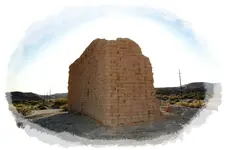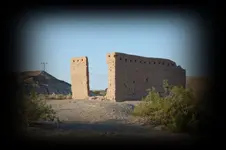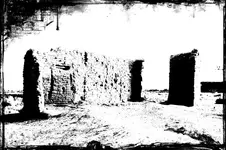oh sorry, I saw the "tucked away....." and didn't catch the
easily accesible part

There is no doubt in my mind, that it's been hit many many times. Since the 1960s, southern Californians, packing detectors in their RVs, have made sport of wandering the desert ghost towns, hiking the entire route of the Butterfield stage route, etc... The entire stage route has been mapped out, and is no secret. Even if a place is supposedly off-limits (federal or state supposed rules, indian land, private land, etc...) believe me: they've all been hit. Even if it meant "hitting them at night", they'll have been worked. Even if someone on site says "no one's ever metal detected here", trust me: when it's this close to the road, beckoning passer-bys, someone will have worked the snot out of it, whether or not a current on-site person knows or thinks

Sometimes the best places to hit (ruins like that) are places that are not in any history books (thus an easy researched spot for anyone and everyone to drive right up to). Or if found in a book, a out-of-place citation, or old out-of-print book, etc .....
For example: a friend and I got ready to tour the entire desert southwest, from CA to New Mexico, planning to work all sort of old sites. Naturally we did the gut-instinct thing, and reached for the obvious Sunset Home and Garden type "Ghost towns" books. You know, the glossy books you get at tourist shops, or from Borders bookstore, etc.... But we began to see that without exception, every stop we came to was invariably a tourist-trap type done-up place. Or to the extent that some were just remote ruins and foundations, invariably they were hunted to death, with all sorts of 4-wheeler cr*p (bullet shells, party trash, etc...) and bottle digger holes all over the place. We began to see that everyone and their brother picks up these books, and rushes out to the easy "ghost town" sites, simply because ... duh... they're
ghost towns 
So we began to scout the back-roads looking for sites of our own: like foundations out in the desert, old cross-routes near water sources that would've made ideal camp spots, old-town urban demolition, etc... We purposefully steared clear of any "lead" that was in easy to access books. When we stopped and researched for old fort sites, etc... in little town libraries we came to, we would only follow after a lead, if it was simply only in hard to get /find sources, and not listed or talked about in the glossy coffee table type books.
Or for stage stops, if they had an exact location given, we would stear clear. But if the citation was vague, and no exact spot pinpointed, THEN we would pursue it. The idea then was, that others would give up, if there wasn't an exact "x-marks the spot" and signs leading you to an obvious ruin right off the road.






 )
) 


